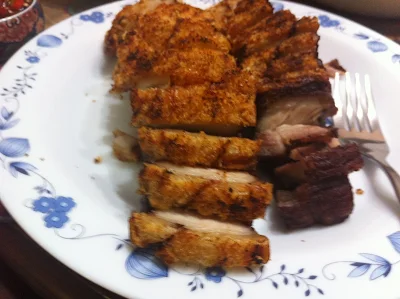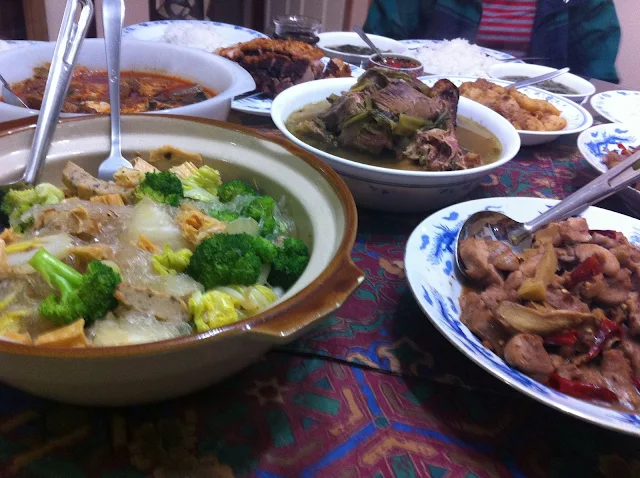
What can I expect on a themed evening, and one that is attractively Greek? I have watched enough Hollywood made movies with the hype of breaking plates and all that at such functions. Realistically, I knew it was going to be a meat night. The air was still nippy and my group could not literally find parking along the busy stretch of Princes Highway leading north and just before Tom Ugly's Bridge, a key landmark that separates Sutherland Shire ( 'the Shire") from the rest of greater Sydney. And then we found a better spot for the car towards the water, that of the King Georges River, the main arterial waterway in Sydney's south. We followed the rules and had to cross the overhead pedestrian bridge over the Highway.
Once we survived all that, plus the increasingly nippy air for the first week of September in the southern hemisphere, we were welcomed with already grilled bite sized lamb pieces from an experienced barbecue looking guy manning the front grill. Oh yes, the expected lamb on a spit. It was already getting relaxed noisy inside Mike's Grill & Bar, with easy to read menus on the large wall and with more women diners than guys. We figured out there could be more than just one birthday party. There were easily a hundred diners in the restaurant. The last time we were there we did not feel the sense of being in Mykonos or Santorini - tonight we were transported there, although I also thought we must have been in Slyvania. The staff were quick to organise things, get us seated, commence the train of snacks and kindly allowed us the reds that we thought was okay to bring in. There was a mobile DJ, a small dance floor and tightly packed tables so close beside each other that you could easily start a conversation with strangers.
I enjoyed the fresh salads most of all. The breads, whether in Turkish, olive-flavoured or
unleavened
pita traditions, got us going - but hey, we were already having our lamb first! I did find the calamari
fritti rather on the damp side, but they were more than made up by the slow roasted chicken pieces in a gravy of spices, red wine and tomato. Tasted more Italian, I reckoned. Of course, black and green olives were everywhere. The
spanakopita, a baked pastry with spinach fillings and
fetta cheese inside, were easy to cuddle up to. I did not warm up to the baked
pastitsio, a baked pasta dish utilising ground beef and
bechamel sauce
. Grilled
hulloumi cheese with a slice of lemon was the iconic Greek that evening in the sumptous course.
Hulloumi has origins in Cyprus and is unripened but brined cheese similar to the
mozarella, utilising both the milk of goats and sheep.
This was the kind of meal that one sits with family, mates and the special one, but mind you, they are all there at the same table. And the
souvlaki with
tzatziki (cucumber and yogurt dips
) had to make an appearance, at the end, when I was getting full and Franco had to get some clear hard liquor.
Souvlaki hails from the days of the philosopher Aristotle, offering bite-sized cuts instead of steak portions.
Next it got more merry and groggy. The Greek necked bowl lute, the
bouzouki, made an appearance and started some very cultural tunes and it finally led to a parade of fifty or more ladies dancing happily not just in the restaurant, but out along the streets of Slyvania. What a sight, passing motorists should be lucky to see all this and not endure the eleven hour air flight to Athens. I then further realised dining in a Greek setting was more than eating, it was a communal get together, letting go of one's hair and re-affirming the bonds of friendships and relationships. The diners at Mike's Grill that evening clapped easily, spontaneously and with a musical flair.
Mike's runs three separate restaurants, at the Royal Hotel in Sutherland, NSW; this joint I went to; and across the Princes Highway, all with their own unique menus. If it was not Greek night, the north bound outlet just before Tom Ugly's offers a variety of seafood, Italian pastas and wood fired pizzas. Think of the pork set of ribs, five spiced king prawns and Portuguese styled chicken skewers as stand outs. Greek Night is held on the first Friday evening of each month at the north bound restaurant.
Would I return? A definite yes. Thanks , Andy, for driving us back that night, you were our Plan B, so in Australian Motor Registry speak. We each felt like waking up on some beach the next day, like Wollongong, to recover from an eye opening experience. Maybe it is more necessary to cycle or have a run, for the women have had their dance at Mike's Grill, whilst most of the men just sat around. Good to catch up with Tez, good to discover an innovative eating and social experience. It was better than Greek yumcha!


















































